Come funziona un amplificatore audio per auto? – La fase di input
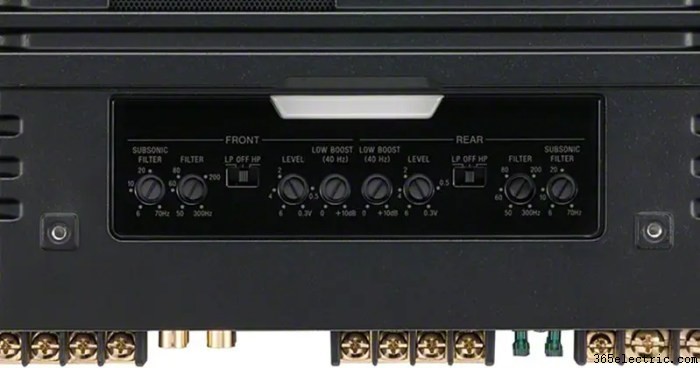
È ora di esaminare la fase di input di come funziona un moderno amplificatore audio per auto. Lo stadio di ingresso è responsabile dell'interfaccia con la tua radio e fornisce funzioni come il controllo del guadagno, i crossover, il potenziamento dei bassi, il controllo del livello a distanza e la somma del segnale che l'installatore utilizzerà per rendere il tuo impianto stereo eccezionale e funzionare in modo affidabile. Sebbene non sia necessario entrare nelle specifiche dei componenti di questa parte del tuo amplificatore, comprendere l'importanza delle funzionalità è fondamentale per scegliere la soluzione giusta per le tue applicazioni.
Ingressi preamplificatore RCA e livello altoparlante
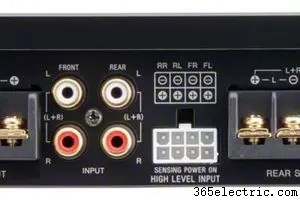 Il tuo amplificatore non può amplificare un segnale audio se non riesci a collegare l'amplificatore alla tua radio. Quasi tutti gli amplificatori sul mercato hanno jack di ingresso RCA che consentono all'installatore di collegare una radio aftermarket in modo rapido e semplice. Diciamo "quasi" perché alcuni amplificatori sono progettati esclusivamente per l'integrazione con sistemi audio installati in fabbrica. Questi amplificatori possono avere una serie di cavi su un cablaggio a treccia per accettare i segnali.
Il tuo amplificatore non può amplificare un segnale audio se non riesci a collegare l'amplificatore alla tua radio. Quasi tutti gli amplificatori sul mercato hanno jack di ingresso RCA che consentono all'installatore di collegare una radio aftermarket in modo rapido e semplice. Diciamo "quasi" perché alcuni amplificatori sono progettati esclusivamente per l'integrazione con sistemi audio installati in fabbrica. Questi amplificatori possono avere una serie di cavi su un cablaggio a treccia per accettare i segnali.
Nella maggior parte dei casi, i segnali a livello di altoparlante non sono diversi da un segnale di preamplificatore, a parte il fatto che hanno solitamente una tensione più alta e, poiché sono già passati attraverso uno stadio dell'amplificatore (nella radio o nell'amplificatore installati in fabbrica), possono contenere un po' di più distorsione.
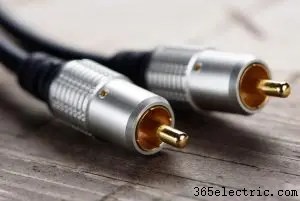 Se l'amplificatore utilizza segnali a livello di preamplificatore o altoparlanti, dovrebbe avere una funzione chiamata ingressi differenziali bilanciati o una variazione di quelle parole. Questo semplice circuito confronta il segnale (o rumore) sul conduttore centrale e lo schermo di un'interconnessione RCA e utilizza un Op-Amp (un piccolo circuito integrato che può essere configurato per confrontare o combinare due segnali in un'unica uscita) per rimuovere qualsiasi cosa comune a entrambi i conduttori. Se si utilizzano interconnessioni a doppino intrecciato, il rumore EMI o RFI dovrebbe essere comune a entrambi i conduttori e quindi sarà ridotto o eliminato da questo circuito. Quando acquisti un amplificatore, gli ingressi differenziali bilanciati sono una delle prime cose che dovresti chiedere al venditore.
Se l'amplificatore utilizza segnali a livello di preamplificatore o altoparlanti, dovrebbe avere una funzione chiamata ingressi differenziali bilanciati o una variazione di quelle parole. Questo semplice circuito confronta il segnale (o rumore) sul conduttore centrale e lo schermo di un'interconnessione RCA e utilizza un Op-Amp (un piccolo circuito integrato che può essere configurato per confrontare o combinare due segnali in un'unica uscita) per rimuovere qualsiasi cosa comune a entrambi i conduttori. Se si utilizzano interconnessioni a doppino intrecciato, il rumore EMI o RFI dovrebbe essere comune a entrambi i conduttori e quindi sarà ridotto o eliminato da questo circuito. Quando acquisti un amplificatore, gli ingressi differenziali bilanciati sono una delle prime cose che dovresti chiedere al venditore.
Funzioni di elaborazione del segnale
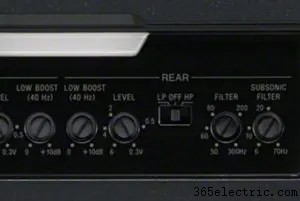 La prossima caratteristica importante in qualsiasi amplificatore è la sensibilità o il controllo del guadagno. This adjustment allows your installer to configure the amp to produce maximum power for a specific voltage that matches the maximum undistorted output of your source unit, or your power requirements based on the design of your audio system. The gain control is something that should be set once using an oscilloscope and a real-time analyzer (RTA), then not touched again unless the design of the system changes.
La prossima caratteristica importante in qualsiasi amplificatore è la sensibilità o il controllo del guadagno. This adjustment allows your installer to configure the amp to produce maximum power for a specific voltage that matches the maximum undistorted output of your source unit, or your power requirements based on the design of your audio system. The gain control is something that should be set once using an oscilloscope and a real-time analyzer (RTA), then not touched again unless the design of the system changes.
Most modern amplifiers include some form of electronic crossover that limits the range of frequencies that pass from the inputs to the outputs. A high-pass crossover only allows frequencies higher than the crossover point to pass and would be used on midrange and high-frequency speakers. A low-pass crossover allows audio signals lower in frequency than the crossover point to pass through the amp. This type of crossover would be used for woofers and subwoofers. Depending on the design of your audio system and the features of your amplifier, your installer may choose to combine high- and low-pass crossovers to create what is known as a band-pass crossover. This crossover would be used on midrange or midbass drivers to cut out low- and high-frequency information.
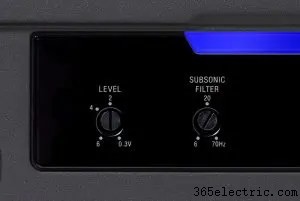 Many amplifiers have a bass boost control. This control operates as a single-band equalizer that the technician installing your sound system can use to reinforce a narrow band of frequencies being sent to a subwoofer. In reality, adding a narrow-bandwidth boost to your audio signal, from a purist perspective, makes no sense. Most systems sound better with proper DSP equalization to deliver smooth and predictable response across the entire operating range from 20 Hz to the upper limit of your sub around 60 or 70 Hz. A peak at any particular point will sound unnatural.
Many amplifiers have a bass boost control. This control operates as a single-band equalizer that the technician installing your sound system can use to reinforce a narrow band of frequencies being sent to a subwoofer. In reality, adding a narrow-bandwidth boost to your audio signal, from a purist perspective, makes no sense. Most systems sound better with proper DSP equalization to deliver smooth and predictable response across the entire operating range from 20 Hz to the upper limit of your sub around 60 or 70 Hz. A peak at any particular point will sound unnatural.
Remote Level Controls
Most high-quality subwoofer amplifiers come with a remote level control or remote bass boost control that can be installed in the front of the vehicle. This control allows the driver to turn the bass up or down to suit the music he is listening to or his mood. When shopping for an amp, look for units that offer a level control as opposed to a bass boost. As we mentioned above, adding emphasis to a narrow band of frequencies doesn’t sound as natural as turning as adjusting the overall output of the subwoofer.
Amplifiers with Integrated DSP
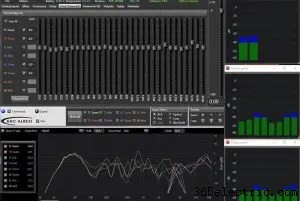 A friend of ours was in charge of developing a series of high-end amplifiers for one of the well-known head-unit manufacturers. The goal was to include as much flexibility as possible in terms of crossovers and signal summing. The complexity of the amp grew to a point where it was becoming difficult to fit all the switches and adjustments on the side of the amp. To provide their clients with the features they wanted, the company decided to remove all the controls and implement a digital signal processor (DSP) to handle everything. Now, the installer could combine signals from multiple sources, set crossovers very accurately and equalize the signal to deliver a smooth and predictable response from the speakers. Sure, your technician will need to connect a computer to the amp, but the results will be fantastic!
A friend of ours was in charge of developing a series of high-end amplifiers for one of the well-known head-unit manufacturers. The goal was to include as much flexibility as possible in terms of crossovers and signal summing. The complexity of the amp grew to a point where it was becoming difficult to fit all the switches and adjustments on the side of the amp. To provide their clients with the features they wanted, the company decided to remove all the controls and implement a digital signal processor (DSP) to handle everything. Now, the installer could combine signals from multiple sources, set crossovers very accurately and equalize the signal to deliver a smooth and predictable response from the speakers. Sure, your technician will need to connect a computer to the amp, but the results will be fantastic!
Great Features and Great Design
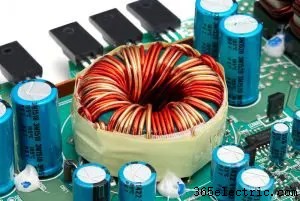 As important as the features of the amplifier you choose are, the design and component layout of the input stage of a car audio amplifier can have a huge effect on the performance of the amp. Keeping these components away from noisy sections of the amp like the power supply and output stage can dramatically reduce the signal-to-noise ratio of the amp. For this reason, larger amplifiers often sound and perform better than their compact counterparts. As with any design, the electronics engineers and technicians who develop the circuits and lay out the components have to balance performance, features, cost and size.
As important as the features of the amplifier you choose are, the design and component layout of the input stage of a car audio amplifier can have a huge effect on the performance of the amp. Keeping these components away from noisy sections of the amp like the power supply and output stage can dramatically reduce the signal-to-noise ratio of the amp. For this reason, larger amplifiers often sound and perform better than their compact counterparts. As with any design, the electronics engineers and technicians who develop the circuits and lay out the components have to balance performance, features, cost and size.
Find the Latest Car Audio Amplifiers at Your Local Car Stereo Shop
When it’s time to shop for a new amplifier for your car, truck, motorcycle or boat, make some notes about why you need an amp and what you want it to do. Armed with that information, the product specialists at your local stereo shop can help you find a solution that will meet your requirements quickly and efficiently and ensure that your mobile audio system sounds magnificent.
